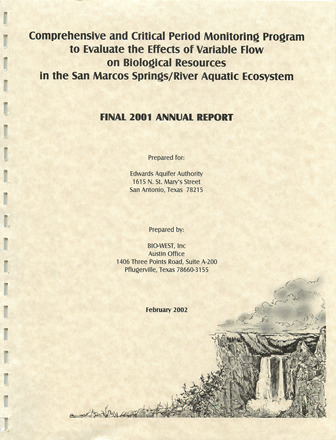Comprehensive and Critical Period Monitoring Program to Evaluate the Effects of Variable Flow on Biological Resources in the San Marcos Springs/River Aquatic Ecosystem Final 2001 Annual Report

| Summary |
|
The purpose of this report is to document the results of all aquatic ecosystem monitoring conducted in 2001 at San Marcos Springs located in San Marcos, Texas. The monitoring and report preparation was performed by BIO-WEST, Inc. Pflugerville, Texas. [Excerpted from Executive Summary] During 2001 the conditions in the San Marcos Springs/River ecosystem were representative of a wet winter and spring followed by the typical summertime decline. However, unlike summer 2000, a large rainfall event occurred in late summer (September 2001), and moderate-to-high rainfall conditions occurred throughout the remainder of the fall, including a major event in November 2001. No critical period samples were triggered by low-flow events in 2001, but one full sampling event (high flow) was conducted following the intense flooding in November 2001 (24-hour mean discharge reached levels that have occurred less than 0.1% of the time in the recorded hydrograph). … Throughout this time period, the San Marcos Springs/River ecosystem can be characterized as an ecosystem with very high water quality for the chemical and physical variables that were measured. … Aquatic vegetation remained abundant throughout the study period and provided suitable habitat for biological communities. … The most interesting observation from the Texas wild-rice data is the decrease in total coverage ( -7%, > 135 square meters [m2]) that occurred between the summer and high-flow sampling events. … Fountain darters were collected from each sampling reach during each sampling event. The overall size-class distribution is typical of a healthy fish assemblage although shifted towards larger fish than those observed in the Comal ecosystem. … By all indications, the densities of giant ramshorn snails (Marisa cornuarietis) observed in the San Marcos Springs/River ecosystem during the study period to date pose no serious threat to the aquatic vegetation. However, because of the impact that this exotic species can have under heavier densities, close monitoring of this species should continue. The gill parasite that has been reported infesting the fountain darter in the Comal ecosystem was not visually evident in fountain darters collected from the San Marcos Springs/River ecosystem. … Suitable habitat for the San Marcos salamander (Eurycea nana) was noted in Spring Lake and below Spring Lake Dam; San Marcos salamanders were observed in each area during each sampling event. … The high-flow event conducted in concert with quarterly sampling has provided an excellent opportunity to assess the recovery potential of the San Marcos Springs/River ecosystem. … The high-flow event was the final sampling effort conducted in 2001; thus, the recovery potential will not be evaluated until the winter 2002 sampling effort. … One conclusion that can be made is that this study is the most comprehensive biological evaluation that has ever been conducted on the San Marcos Springs/ River ecosystem. |
Search for Documents
Advance Search
Explore EAA's Scientific Reports
- All Reports
- Groundwater Recharge, Recharge Zone
- Groundwater Movement
- Geomorphology and Caves
- Weather Modification
- Geology
- Water Use and Conservation
- Geochemistry
- Water Resources Planning and Management
- Floods and Drought
- Water Quality
- Climatology
- Surface Water / Groundwater Relationship
- Biology
- Springs, Groundwater Discharge
- Archaeology
- RZ Protection
- Aquifer Levels
- Remote Sensing
- Precipitation
- Overview Studies
- Modeling
- Hydrology and Hydrogeology
- History
